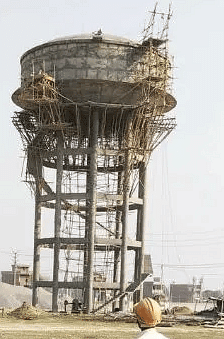UPSC Exam > UPSC Notes > Civil Engineering Optional Notes for UPSC > RCC Water Tank Design Requirements
RCC Water Tank Design Requirements | Civil Engineering Optional Notes for UPSC PDF Download
Design of Reinforced Concrete Water Tanks
Reinforced concrete water tanks are essential structures designed for storing water. These tanks are constructed following the guidelines in IS 3370: 2009 (Parts I – IV) and can be located overhead, on the ground, or underground. The design and construction depend on the tank's location and shape, with common shapes being circular and rectangular.Types of RCC Water Tanks
Based on Location:- Underground Tanks
- Tanks Resting on Ground
- Overhead Tanks
Based on Shape:
- Rectangular Tank
- Circular Tank
- Spherical Tank
- Intze Tank
- Circular Tank with Conical Bottom
 Above ground RCC water tank
Above ground RCC water tank
 Under ground RCC water tank
Under ground RCC water tank
 Overhead RCC water tank
Overhead RCC water tank
Basis of Concrete Water Tank Design
The design of RCC water tanks must ensure sufficient resistance to cracking to prevent leakage and maintain adequate strength. Key design assumptions include:- Plane Sections Remain Plane: The sections remain flat before and after bending.
- Elastic Behavior: Both concrete and steel behave elastically.
- Modular Ratio: Values are derived from IS 456 - Table 21.
- Concrete Tensile Stress: Limited to values provided in the relevant standards to prevent cracking.
Stress Considerations:
- Tensile stress is ignored during strength calculations.
- Stresses are calculated for both flexural and direct tension or their combinations.
 Stresses in a RCC water tank
Stresses in a RCC water tank
Permissible Stresses on concrete
For Cracking Resistance:- Concrete must be free of leakage.
- The grade of concrete should be M20 or higher.
- Permissible stresses are given in tables for different concrete grades, ensuring the stress does not exceed specified limits.
For Strength Calculations:
- Permissible stresses in compression and bond stress are provided for different concrete grades.
- Shear stress values are also specified.
Permissible Stress in Steel
The stress in steel must not exceed specified values to prevent concrete cracking. For mild steel bars, the limit is 115 N/mm² when in contact with the liquid and 125 N/mm² when away from the liquid. For high-strength deformed bars, the limits are 150 N/mm² and 190 N/mm², respectively. Reinforcement in water tanks
Reinforcement in water tanks
Stress Due to Temperature or Moisture Variations
To manage temperature and moisture variations, the following measures are recommended:- Minimum reinforcement as specified.
- Movement joints as per IS 3370 (Part 1).
- Ensuring the tank stores water or aqueous liquids near surrounding temperatures.
- Preventing the concrete from drying out during construction and before use.
Floors of Reinforced Concrete Water Tanks
Movement Joints:- Necessary for accommodating expansion and contraction.
- Various types of joints should be used as recommended.
 Various movement joints in water tank floor
Various movement joints in water tank floor
 Reinforced concrete water tank floor above ground
Reinforced concrete water tank floor above ground
Floor Construction:
- A lean concrete layer of at least 75 mm thickness is placed on the ground.
- Polyethylene sheets are used between lean concrete and the tank floor.
- Floors should be cast in a single layer.
- The design must consider bending moments due to dead load and water load, especially for multi-cell tanks.

Concrete Water Tank Walls
Provision of Joints:- Sliding joints allow the walls to expand or contract separately from the floor and prevent moments at the wall base.

Pressure Considerations:
- Gas pressure from the tank cover and earth pressure from surrounding soil must be considered in the wall design.

RCC Water Tank Roof
The roof must ensure water-tightness and accommodate movement joints corresponding to the walls. Stresses must be limited, or waterproof membranes used.
Minimum Reinforcement
- Sections thinner than 225 mm require at least 0.3% reinforcement.
- For sections thicker than 450 mm, the reinforcement can be reduced to 0.2%.
- For floor slabs resting on the ground, practical minimum reinforcement is 0.3%.
- Sections 225 mm and thicker should have two layers of reinforcement, one near each face.
By adhering to these design principles and standards, RCC water tanks can achieve the required durability, strength, and resistance to cracking, ensuring efficient and long-lasting water storage solutions.
The document RCC Water Tank Design Requirements | Civil Engineering Optional Notes for UPSC is a part of the UPSC Course Civil Engineering Optional Notes for UPSC.
All you need of UPSC at this link: UPSC
|
350 videos|464 docs|2 tests
|
|
350 videos|464 docs|2 tests
|
Download as PDF

|
Explore Courses for UPSC exam
|

|
Signup for Free!
Signup to see your scores go up within 7 days! Learn & Practice with 1000+ FREE Notes, Videos & Tests.
Related Searches
















